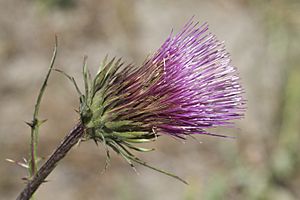Anderson's thistle facts for kids
Quick facts for kids Anderson's thistle |
|
|---|---|
 |
|
| Scientific classification | |
| Genus: |
Cirsium
|
| Species: |
andersonii
|
| Synonyms | |
|
|
Cirsium andersonii is a type of thistle plant found in North America. It is often called Anderson's thistle or rose thistle. This plant grows naturally in California, Oregon, and Nevada. It likes to live in forests and open areas of high mountains. You can find it in places like the Sierra Nevada and the southern Cascade Range. It has also been seen in Idaho.
About Anderson's Thistle
Anderson's thistle is a plant that lives for many years. It can grow straight up to about 100 centimeters (almost 40 inches) tall. It can have one main stem or many stems. These stems can be smooth or covered in a soft, woolly fuzz.
What It Looks Like
The leaves of this thistle are deeply cut and have sharp edges. They grow on stalks that have spiny wings. The longest leaves are near the bottom of the plant. They can be over 30 centimeters (about 12 inches) long.
The plant produces one or more flower heads. Each flower head can be up to 5 centimeters long and 4 centimeters wide. These heads are surrounded by spiny, purple-tipped leaves called phyllaries. These phyllaries curve outwards.
Inside each flower head are many colorful flowers. They can be red, purplish, or rose pink. Each flower can be up to 4.5 centimeters long. These bright flowers are very attractive to hummingbirds.
After the flowers bloom, the plant produces a fruit called an achene. This fruit has a brown body that is about 6 or 7 millimeters long. On top of the fruit is a feathery part called a pappus. This pappus can be up to 4 centimeters long.
How It Got Its Name
This thistle was first named Cnicus andersonii. It was named by a scientist named Asa Gray after Charles Lewis Anderson. Later, another scientist named Petrak changed its name to Cirsium andersonii.
See also
 In Spanish: Cirsium andersonii para niños
In Spanish: Cirsium andersonii para niños

